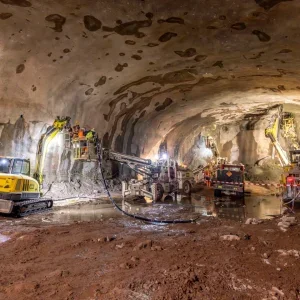Contractor Balfour Beatty will construct the UK’s 1.9km long twin tube Hindhead road tunnel using the Sprayed Concrete Lining (SCL) method. The decision will see the first use of SCL to construct a major UK tunnel since the 3.2km long North Downs Tunnel over three years ago.
The tunnel lies along a new 6.7km long stretch of carriageway designed to relieve traffic congestion between London and the south coast city of Portsmouth. Balfour Beatty was awarded the ‘Early Contractor Involvement’ (ECI) contract in September 2002 by the client, the Highways Agency, and has developed the design with consultant Mott MacDonald.
The twin bore tunnels will have a horseshoe shaped cross section with a maximum internal diameter of 10.8m, and a cross passage every 100m. Excavation will be through the Hythe Beds, a variable sequence of interbedded sands and sandstones. The sands are typically medium dense to dense clayey, fine to medium sand. The sandstone are very weak to moderately weak, fine to medium grained sandstone with a gradational increase in sandstone with depth. The tunnel is located within these lower, more competent strata.
Both tunnels will be excavated from the north portal using a 6m high heading and a bench sequence with a sprayed concrete support. The invert will be removed after breakthrough of both the heading and bench. An excavator, fitted with an articulated backactor arm and bucket, will drive the tunnels, with the spoil transferred onto a conveyor and transported to a stockpile outside the portal.
Lining will comprise 150mm of steel fibre reinforced primary sprayed concrete lining, a waterproof membrane and a 225mm thick, un-reinforced, in-situ concrete secondary lining. Lattice girders and spiling will be used as necessary to provide additional support with rock bolting only being needed as a contingency measure.
Other construction methods were also considered. TBMs were thought overly expensive, particularly with the number of cross passages needed. Perforex was discounted early on and roadheaders were thought to be less flexible than excavators. It was decided that roadheaders were more likely to increase dust levels and very fine spoil due to the nature of the friable sandstone. Also, the short advance lengths did not provide particular benefits in excavation times.
Paul Hoyland, Balfour Beatty’s contract manager for the Hindhead Tunnel, told T&TI: “Considering the ground conditions we expect to encounter, the shape of the tunnel and the number of openings and cross passages required, I believe the Sprayed Concrete Lining technique is a cost effective, flexible and safe technique for the A3 Hindhead Scheme.”
Construction is scheduled to commence in mid 2005, with completion of tunnel excavation and lining by mid 2008, ready for the opening of the road in mid 2009.







